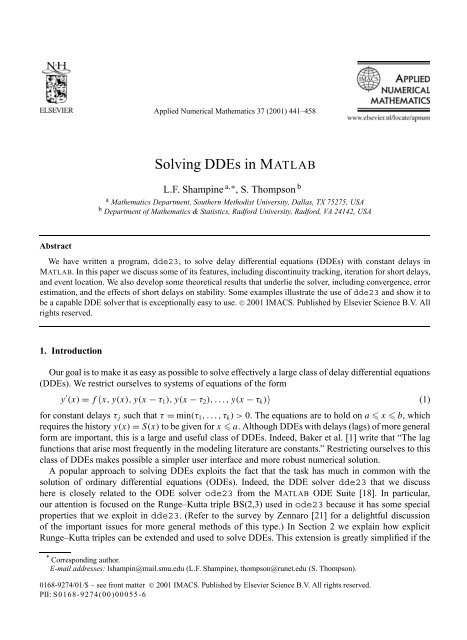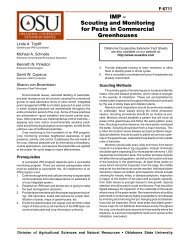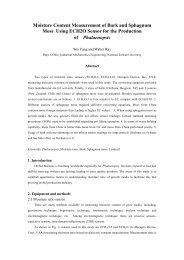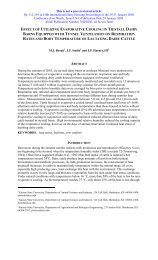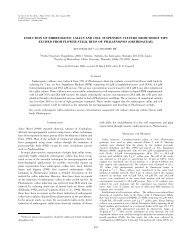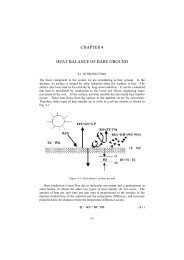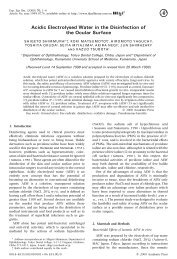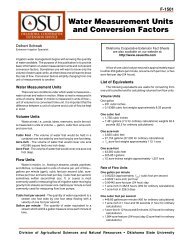Solving DDEs in MATLAB
Solving DDEs in MATLAB
Solving DDEs in MATLAB
You also want an ePaper? Increase the reach of your titles
YUMPU automatically turns print PDFs into web optimized ePapers that Google loves.
Applied Numerical Mathematics 37 (2001) 441–458<br />
<strong>Solv<strong>in</strong>g</strong> <strong>DDEs</strong> <strong>in</strong> <strong>MATLAB</strong><br />
L.F. Shamp<strong>in</strong>e a,∗ , S. Thompson b<br />
a Mathematics Department, Southern Methodist University, Dallas, TX 75275, USA<br />
b Department of Mathematics & Statistics, Radford University, Radford, VA 24142, USA<br />
Abstract<br />
We have written a program, dde23, to solve delay differential equations (<strong>DDEs</strong>) with constant delays <strong>in</strong><br />
<strong>MATLAB</strong>. In this paper we discuss some of its features, <strong>in</strong>clud<strong>in</strong>g discont<strong>in</strong>uity track<strong>in</strong>g, iteration for short delays,<br />
and event location. We also develop some theoretical results that underlie the solver, <strong>in</strong>clud<strong>in</strong>g convergence, error<br />
estimation, and the effects of short delays on stability. Some examples illustrate the use of dde23 and show it to<br />
be a capable DDE solver that is exceptionally easy to use. © 2001 IMACS. Published by Elsevier Science B.V. All<br />
rights reserved.<br />
1. Introduction<br />
Our goal is to make it as easy as possible to solve effectively a large class of delay differential equations<br />
(<strong>DDEs</strong>). We restrict ourselves to systems of equations of the form<br />
y ′ (x) = f x,y(x),y(x − τ1), y(x − τ2), . . ., y(x − τk) <br />
(1)<br />
for constant delays τj such that τ = m<strong>in</strong>(τ1,...,τk)>0. The equations are to hold on a x b, which<br />
requires the history y(x) = S(x) to be given for x a. Although <strong>DDEs</strong> with delays (lags) of more general<br />
form are important, this is a large and useful class of <strong>DDEs</strong>. Indeed, Baker et al. [1] write that “The lag<br />
functions that arise most frequently <strong>in</strong> the model<strong>in</strong>g literature are constants.” Restrict<strong>in</strong>g ourselves to this<br />
class of <strong>DDEs</strong> makes possible a simpler user <strong>in</strong>terface and more robust numerical solution.<br />
A popular approach to solv<strong>in</strong>g <strong>DDEs</strong> exploits the fact that the task has much <strong>in</strong> common with the<br />
solution of ord<strong>in</strong>ary differential equations (ODEs). Indeed, the DDE solver dde23 that we discuss<br />
here is closely related to the ODE solver ode23 from the <strong>MATLAB</strong> ODE Suite [18]. In particular,<br />
our attention is focused on the Runge–Kutta triple BS(2,3) used <strong>in</strong> ode23 because it has some special<br />
properties that we exploit <strong>in</strong> dde23. (Refer to the survey by Zennaro [21] for a delightful discussion<br />
of the important issues for more general methods of this type.) In Section 2 we expla<strong>in</strong> how explicit<br />
Runge–Kutta triples can be extended and used to solve <strong>DDEs</strong>. This extension is greatly simplified if the<br />
* Correspond<strong>in</strong>g author.<br />
E-mail addresses: lshamp<strong>in</strong>@mail.smu.edu (L.F. Shamp<strong>in</strong>e), thompson@runet.edu (S. Thompson).<br />
0168-9274/01/$ – see front matter © 2001 IMACS. Published by Elsevier Science B.V. All rights reserved.<br />
PII: S0168-9274(00)00055-6
442 L.F. Shamp<strong>in</strong>e, S. Thompson / Applied Numerical Mathematics 37 (2001) 441–458<br />
maximum step size H is smaller than τ because the result<strong>in</strong>g formulas are explicit. This is no restriction<br />
when prov<strong>in</strong>g convergence as H → 0, so many papers assume it. However, we believe that it is not<br />
acceptable <strong>in</strong> a quality solver, so we also discuss how to evaluate the implicit formulas that arise when<br />
the step size is bigger than τ . In Section 3 we prove uniform convergence of the numerical scheme <strong>in</strong><br />
realistic circumstances. In the follow<strong>in</strong>g section we justify an estimate of the local truncation error.<br />
Generally y ′ (a+) from (1) is different from y ′ (a−) = S ′ (a−). It is characteristic of <strong>DDEs</strong> that this<br />
discont<strong>in</strong>uity <strong>in</strong> y ′ propagates as a discont<strong>in</strong>uity <strong>in</strong> y ′′ at a + τ1,...,a+ τk. In turn these discont<strong>in</strong>uities<br />
propagate as a discont<strong>in</strong>uity <strong>in</strong> y (3) , and so forth. Locat<strong>in</strong>g and account<strong>in</strong>g for low-order discont<strong>in</strong>uities<br />
<strong>in</strong> the solution is key to the use of Runge–Kutta methods for solv<strong>in</strong>g <strong>DDEs</strong>. In Section 5 we discuss the<br />
practical issues of locat<strong>in</strong>g these discont<strong>in</strong>uities. Any DDE solver must account for them, but dde23<br />
also deals with discont<strong>in</strong>uous changes <strong>in</strong> f at known po<strong>in</strong>ts x <strong>in</strong> both the history and the <strong>in</strong>terval of<br />
<strong>in</strong>tegration <strong>in</strong> a similar way.<br />
Some problems <strong>in</strong>volve changes <strong>in</strong> f at po<strong>in</strong>ts that depend on the solution itself, or more generally on<br />
a function of the solution called an event function. Event functions are used to locate where y satisfies<br />
certa<strong>in</strong> conditions, e.g., where a specific component of y(x) has a local maximum. dde23 has a powerful<br />
event location capability that is discussed <strong>in</strong> Section 6. It is difficult to deal with the many possibilities<br />
that are seen <strong>in</strong> practice, so provid<strong>in</strong>g this capability affected profoundly the design of the solver.<br />
The natural step size of a Runge–Kutta method is the largest that will yield the desired accuracy.<br />
Delays that are long compared to this step size and delays that are short present special difficulties for a<br />
DDE solver that we consider <strong>in</strong> Section 7. In this we prove a result about the stability of the numerical<br />
scheme for small delays.<br />
We close with a pair of examples that show restrict<strong>in</strong>g the class of problems, algorithmic developments,<br />
language facilities <strong>in</strong> <strong>MATLAB</strong>, and design have resulted <strong>in</strong> a DDE solver that is both capable and<br />
exceptionally easy to use. We have prepared a tutorial that shows how to use dde23. The solver and<br />
its auxiliary functions, the tutorial, and complete solutions of many examples from the literature are<br />
available at http://www.runet.edu/~thompson/webddes/.<br />
2. Formulas<br />
Explicit Runge–Kutta triples are a standard way to solve the ODE problem y ′ = f(x,y) on [a,b]<br />
with given y(a). They can be extended to solve <strong>DDEs</strong>. Indeed, dde23 is closely related to the ODE<br />
solver ode23 [18] which implements the BS(2,3) triple [2]. A triple of s stages <strong>in</strong>volves three formulas.<br />
Suppose that we have an approximation yn to y(x) at xn and wish to compute an approximation at<br />
xn+1 = xn + hn.Fori = 1,...,s, the stages fni = f(xni,yni) are def<strong>in</strong>ed <strong>in</strong> terms of xni = xn + cihn and<br />
i−1<br />
<br />
yni = yn + hn<br />
j=1<br />
aij fnj .<br />
The approximation used to advance the <strong>in</strong>tegration is<br />
yn+1 = yn + hn<br />
s<br />
i=1<br />
bifni.
L.F. Shamp<strong>in</strong>e, S. Thompson / Applied Numerical Mathematics 37 (2001) 441–458 443<br />
For brevity we may write this <strong>in</strong> terms of the <strong>in</strong>crement function<br />
s<br />
Φ(xn,yn) = bifni.<br />
i=1<br />
The solution satisfies this formula with a residual called the local truncation error, lten,<br />
y(xn+1) = y(xn) + hnΦ xn,y(xn) + lten.<br />
For sufficiently smooth f and y(x) this error is O(hp+1 n ). The triple <strong>in</strong>cludes another formula,<br />
y ∗ n+1 = yn<br />
s<br />
+ hn b ∗ i fni = yn + hnΦ ∗ (xn,yn).<br />
i=1<br />
The solution satisfies this formula with a local truncation error lte ∗ n that is O(hpn ). This second formula is<br />
used only for select<strong>in</strong>g the step size. The third formula has the form<br />
s<br />
yn+σ = yn + hn bi(σ )fni.<br />
i=1<br />
The coefficients bi(σ ) are polynomials <strong>in</strong> σ , so this represents a polynomial approximation to y(xn +<br />
σhn) for 0 σ 1. We assume that this formula yields the value yn when σ = 0andyn+1when σ = 1.<br />
For this reason the third formula is described as a cont<strong>in</strong>uous extension of the first. A much more serious<br />
assumption is that the order of the cont<strong>in</strong>uous extension is the same as that of the first formula. These<br />
assumptions hold for the BS(2,3) triple. For such triples we regard the formula used to advance the<br />
<strong>in</strong>tegration as just the special case σ = 1 of the cont<strong>in</strong>uous extension and write<br />
yn+σ = yn + hnΦ(xn,yn,σ).<br />
The local truncation error of the cont<strong>in</strong>uous extension is def<strong>in</strong>ed by<br />
y(xn + σhn) = y(xn) + hnΦ xn,y(xn), σ + lten(σ ).<br />
We assume that for smooth f and y(x), there is a constant C1 such that lten(σ ) C1hp+1 n for<br />
0 σ 1.<br />
In his discussion of cont<strong>in</strong>uous extensions, Dormand [4] treats the local truncation error of the<br />
BS(2,3) triple as an example. In Section 6.3 he obta<strong>in</strong>s<br />
A (4) 2 σ 4 3 2 1/2 (σ ) = 1728σ − 7536σ + 13132σ − 11148σ + 3969 (2)<br />
288<br />
as a measure of the local truncation error at xn + σhn. In Fig. 6.2 he shows that this measure <strong>in</strong>creases<br />
monotonely from zero at xn to a maximum at xn+1. We shall see that the solver controls the size of<br />
the error at xn+1, so the cont<strong>in</strong>uous extension of this triple provides an accurate solution throughout<br />
[xn,xn+1].<br />
To use an explicit Runge–Kutta triple to solve the DDE (1), we need a strategy for handl<strong>in</strong>g the history<br />
terms y(xni − τj) that appear <strong>in</strong><br />
fni = f xni,yni,y(xni − τ1), . . ., y(xni − τk) .<br />
Two situations must be dist<strong>in</strong>guished: hn τ and hn >τj for some j. We beg<strong>in</strong> with the first. Suppose<br />
that we have available an approximation S(x) to y(x) for all x xn.Ifhn τ , then all the xni − τj xn<br />
and<br />
fni = f xni,yni,S(xni − τ1), . . . , S(xni − τk)
444 L.F. Shamp<strong>in</strong>e, S. Thompson / Applied Numerical Mathematics 37 (2001) 441–458<br />
is an explicit recipe for the stage and the formulas are explicit. The function S(x) is the <strong>in</strong>itial history<br />
for x a. After tak<strong>in</strong>g the step to xn+1, we use the cont<strong>in</strong>uous extension to def<strong>in</strong>e S(x) on [xn,xn+1] as<br />
S(xn + σhn) = yn+σ . We are then ready to take another step. This suffices for prov<strong>in</strong>g convergence as the<br />
maximum step size tends to zero, but we must take up the other situation because <strong>in</strong> practice, we may very<br />
well want to use a step size larger than the smallest delay. When hn >τj for some j, the “history” term<br />
S(x) is evaluated <strong>in</strong> the span of the current step and the formulas are def<strong>in</strong>ed implicitly. In this situation<br />
we evaluate the formulas with simple iteration. On reach<strong>in</strong>g xn, wehavedef<strong>in</strong>edS(x) for x xn. We<br />
extend its def<strong>in</strong>ition somehow to (xn,xn + hn] and call the result<strong>in</strong>g function S (0) (x). A typical stage<br />
of simple iteration beg<strong>in</strong>s with the approximate solution S (m) (x). The next iterate is computed with the<br />
explicit formula<br />
S (m+1) (xn + σhn) = yn + hnΦ xn,yn,σ; S (m) (x) .<br />
Here and elsewhere it is convenient to show the dependence on the history by means of another argument<br />
<strong>in</strong> the <strong>in</strong>crement function. In the next section we show that if the step size is small enough, this is a<br />
contraction and S(x) is well-def<strong>in</strong>ed for x xn+1.<br />
In dde23 we predict S (0) (x) to be the constant y0 for the first step. We do not attempt to predict more<br />
accurately then because the solution is not smooth at a and we do not yet know a step size appropriate<br />
to the scale of the problem. Indeed, reduc<strong>in</strong>g the step size as needed to obta<strong>in</strong> convergence of simple<br />
iteration is a valuable tactic for f<strong>in</strong>d<strong>in</strong>g an <strong>in</strong>itial step size that is on scale, cf. [16]. After the first step, we<br />
use the cont<strong>in</strong>uous extension of the preced<strong>in</strong>g step as S (0) (x) for the current step. This prediction has an<br />
appropriate order of accuracy and we can even assess the accuracy quantitatively us<strong>in</strong>g (2). Remarkably,<br />
the truncation error has a local maximum at xn+1 so that extrapolation actually provides a more accurate<br />
solution for some distance. Specifically, the ratio of the error of yn+σ to the error of yn+1 is no larger<br />
than 1 for σ up to about 1.32. Much more important <strong>in</strong> practice is the accuracy of the prediction <strong>in</strong> the<br />
span of a subsequent step of the same size or rather larger. Unfortunately, the ratio grows rapidly as σ<br />
<strong>in</strong>creases. Still, it is no bigger than 13 for 1 σ 2, so the prediction is quite good when the step size<br />
is chang<strong>in</strong>g slowly. The step size adjustment algorithms of dde23 are those of ode23 augmented to<br />
deal with implicit formulas. The convergence test for simple iteration is that y (m+1)<br />
n+1 − y(m) n+1 is no more<br />
than one tenth the accuracy required of yn+1. Because each iteration costs as much as an explicit step,<br />
any proposed hn with τ
L.F. Shamp<strong>in</strong>e, S. Thompson / Applied Numerical Mathematics 37 (2001) 441–458 445<br />
This theorem shows how our method works. A more general convergence result may be found <strong>in</strong> [21].<br />
Before prov<strong>in</strong>g this result, we beg<strong>in</strong> our <strong>in</strong>vestigation of convergence by recall<strong>in</strong>g the comments earlier<br />
about how discont<strong>in</strong>uities arise and propagate for <strong>DDEs</strong>. We know <strong>in</strong> advance all the po<strong>in</strong>ts where the<br />
solution might not be smooth enough for the usual orders of the formulas to hold. Because we consider<br />
one-step methods, if we take these po<strong>in</strong>ts to be mesh po<strong>in</strong>ts, the analysis is the same as if the solution<br />
were smooth throughout the <strong>in</strong>terval. Accord<strong>in</strong>gly, we consider a sequence of meshes {xn} which <strong>in</strong>clude<br />
all these po<strong>in</strong>ts. Just how this is accomplished <strong>in</strong> practice is described <strong>in</strong> Section 5. Between these po<strong>in</strong>ts<br />
we assume that f and y(x) are smooth enough for the formulas to have their usual orders. We also<br />
assume that f satisfies a Lipschitz condition with respect to all the dependent variables. For the sake of<br />
simplicity, we suppose that there is only one delay and take the Lipschitz condition <strong>in</strong> the form<br />
<br />
<br />
f(x,˜y, ˜z) − f(x,y,z) L max ˜y − y, ˜z − z .<br />
The Runge–Kutta formulas extended to <strong>DDEs</strong> <strong>in</strong>volve a history term that we write generically <strong>in</strong> the<br />
<strong>in</strong>crement function as g(x). We require two lemmas about how the <strong>in</strong>crement functions depend on their<br />
arguments.<br />
Lemma 1. There is a constant L such that for 0 σ 1,<br />
<br />
Φ xn, ˜yn,σ; g(x) − Φ xn,yn,σ; g(x) L˜yn − yn. (4)<br />
Proof. In a step of size hn from (xn, ˜yn), the <strong>in</strong>termediate quantities ˜yni are def<strong>in</strong>ed by<br />
i−1<br />
˜yni =˜yn + hn aij f xnj , ˜ynj ,g(xnj − τ) <br />
j=1<br />
and the yni are def<strong>in</strong>ed similarly <strong>in</strong> a step from (xn,yn). Us<strong>in</strong>g the Lipschitz condition on f ,itis<br />
straightforward to show that for each i, there is a constant Li such that<br />
<br />
<br />
i−1<br />
˜yni − yni 1 + HL Lj|aij | ˜yn − yn=Li˜yn − yn.<br />
j=1<br />
With this result it follows easily that (4) holds with L = L s<br />
i=1 Li max(|bi(σ )|). ✷<br />
The second lemma we need is a bound on the effect of us<strong>in</strong>g different history terms.<br />
Lemma 2. Let ∆ be a bound on G(x) − g(x) for all x xn+1. If the maximum step size H is small<br />
enough that<br />
<br />
i−1<br />
|aij | 1 (5)<br />
HLmax<br />
i<br />
j=1<br />
then there is a constant Γ such that<br />
<br />
Φ xn,yn,σ; G(x) − Φ xn,yn,σ; g(x) Γ∆. (6)<br />
Proof. Let the <strong>in</strong>termediate quantities of the two formulas be<br />
i−1<br />
rni = yn + hn aij f xnj ,rnj ,G(xnj − τ) <br />
j=1
446 L.F. Shamp<strong>in</strong>e, S. Thompson / Applied Numerical Mathematics 37 (2001) 441–458<br />
and<br />
i−1<br />
<br />
sni = yn + hn aij f xnj ,snj ,g(xnj − τ) .<br />
j=1<br />
The Lipschitz condition on f , <strong>in</strong>equality (5), and a simple <strong>in</strong>duction argument show that for each i,<br />
i−1<br />
rni − sni hn |aij |L∆ ∆.<br />
j=1<br />
With this result it follows easily that (6) holds with Γ = L s i=1 max(|bi(σ )|).<br />
Recall that if the step size is small enough, the <strong>in</strong>termediate results yni are def<strong>in</strong>ed by the explicit<br />
formulas<br />
i−1<br />
yni = yn + hn aij f xnj ,ynj ,S(xnj − τ) ,<br />
j=1<br />
but if hn >τ, we may have some xnj − τj >xn so that S(x) is evaluated <strong>in</strong> the span of the current step. In<br />
this situation we evaluate the formulas with simple iteration as described <strong>in</strong> the preced<strong>in</strong>g section. Us<strong>in</strong>g<br />
this lemma we obta<strong>in</strong> a condition on the maximum step size that <strong>in</strong>sures the convergence of simple<br />
iteration: Let δ (m) be the maximum of S (m+1) (x) − S (m) (x) for xn x xn+1. (The functions are the<br />
same for x xn.) Inequality (6) implies that δ (m) hnΓδ (m−1) HΓδ (m−1) . From this it is obvious<br />
that simple iteration is contract<strong>in</strong>g and the formula is well-def<strong>in</strong>ed if the maximum step size H is small<br />
enough to satisfy both (5) and<br />
s<br />
HΓ = HL max<br />
i=1<br />
|bi(σ )| 1<br />
. (7)<br />
2<br />
We are now <strong>in</strong> a position to prove convergence as H → 0 when the meshes <strong>in</strong>clude all discont<strong>in</strong>uities<br />
of low order and H satisfies (5) and (7). Suppose that the <strong>in</strong>tegration has reached xn and let En be a<br />
bound on y(x) − S(x) for all x xn. The local truncation error of the cont<strong>in</strong>uous extension is def<strong>in</strong>ed<br />
by<br />
y(xn + σhn) = y(xn) + hnΦ xn,y(xn), σ ; y(x) + lten(σ ).<br />
If we <strong>in</strong>troduce<br />
wn+σ = yn + hnΦ xn,yn,σ; y(x) <br />
then <strong>in</strong>equality (4) and our assumption about the local truncation error imply that for 0 σ 1,<br />
<br />
<br />
<br />
+ lten(σ ) <br />
y(xn + σhn) − wn+σ<br />
(1 + hnL) y(xn) − yn<br />
The numerical solution is<br />
(1 + hnL)En + C1h p+1<br />
n .<br />
yn+σ = yn + hnΦ xn,yn,σ; S(x) .<br />
The next step of the proof is complicated by the possibility that this formula is implicit. If we let ∆ be<br />
the maximum of y(x) − S(x) for x xn+1, then <strong>in</strong>equality (6) states that<br />
<br />
yn+σ − wn+σ =hn<br />
Φ xn,yn,σ; S(x) − Φ xn,yn,σ; y(x) hnΓ∆
L.F. Shamp<strong>in</strong>e, S. Thompson / Applied Numerical Mathematics 37 (2001) 441–458 447<br />
and the triangle <strong>in</strong>equality implies that<br />
<br />
<br />
y(xn + σhn) − yn+σ<br />
(1 + hnL)En + C1h p+1<br />
n<br />
+ hnΓ∆.<br />
This is a bound on y(x) − S(x) for xn x xn+1 and by def<strong>in</strong>ition of En, the bound also holds for all<br />
x xn. We conclude that<br />
∆ (1 + hnL)En + C1h p+1<br />
n<br />
+ hnΓ∆.<br />
With the assumption that H satisfies (7), it then follows that<br />
1 + hnL<br />
∆ <br />
1 − hnΓ En + C1<br />
1 − hnΓ hp+1 n <br />
1 + 2(L + Γ)hn En + 2C1h p+1<br />
n .<br />
If we let C2 = 2(L + Γ)and C3 = 2C1, this <strong>in</strong>equality tells us that<br />
En+1 = (1 + hnC2)En + C3h p+1<br />
n<br />
is a bound on y(x) − S(x) for all x xn+1. Because we start with the given <strong>in</strong>itial history, E0 = 0.<br />
A simple <strong>in</strong>duction argument shows that for all n,<br />
En C3e C2(xn−a)<br />
(xn − a)H p .<br />
The uniform bound<br />
En C3e C2(b−a) p p<br />
(b − a)H = CH<br />
implies (3) for a x b.<br />
4. Error estimation and control<br />
Nowadays codes based on explicit Runge–Kutta triples estimate and control the error made <strong>in</strong> the<br />
current step by the lower order formula. They advance the <strong>in</strong>tegration with the higher order result yn+1<br />
(local extrapolation) because it is more accurate, though just how much is not known. Our notation and<br />
proof of convergence <strong>in</strong>corporate this assumption about the triple. We make use of local extrapolation<br />
<strong>in</strong> our proof that we can estimate the local truncation error of the lower order formula, lte ∗ n ,bythe<br />
computable quantity est = yn+1 − y ∗ n+1 .<br />
The local truncation error<br />
lte ∗ n = y(xn+1) − y(xn) − hnΦ ∗ xn,y(xn); y(x) <br />
is O(hp n ). Us<strong>in</strong>g the correspond<strong>in</strong>g def<strong>in</strong>ition of lten it follows easily that<br />
lte ∗ n = hnΦ xn,y(xn); y(x) − hnΦ ∗ xn,y(xn); y(x) + O h p+1<br />
n .<br />
From the def<strong>in</strong>ition of yn+1 we have<br />
hnΦ xn,yn; S(x) = yn+1 − yn.<br />
Us<strong>in</strong>g the convergence result (3), we show now that<br />
hnΦ xn,y(xn); y(x) = hnΦ xn,yn; S(x) + O hnH p .<br />
First we use <strong>in</strong>equality (4) to see that<br />
<br />
<br />
hnΦ xn,y(xn); y(x) − hnΦ xn,yn; y(x) hnL y(xn) − yn<br />
hnLCH p
448 L.F. Shamp<strong>in</strong>e, S. Thompson / Applied Numerical Mathematics 37 (2001) 441–458<br />
and then <strong>in</strong>equality (6) to see that<br />
<br />
hnΦ xn,yn; y(x) − hnΦ xn,yn; S(x) hnΓCH p .<br />
The desired relation follows from the triangle <strong>in</strong>equality. The same argument establishes the correspond<strong>in</strong>g<br />
relation for the lower order formula. With these two relations we have<br />
lte ∗ n = hnΦ xn,yn; S(x) − hnΦ ∗ xn,yn; S(x) + O hnH p<br />
<br />
+ O hnH p<br />
= (yn+1 − yn) − y ∗ n+1 − yn<br />
= est + O hnH p<br />
which justifies our estimate of the local truncation error.<br />
As with ODEs, the local truncation error can be expanded to<br />
lte ∗ n = φ∗xn,y(xn); y(x) h p n + Oh p+1<br />
n .<br />
If we reject the step of size hn from (xn,yn), we predict the local truncation error of another attempt of<br />
size h to be<br />
est(h/hn) p ≈ φ ∗ xn,y(xn); y(x) h p .<br />
The same prediction applies to a step of size h from (xn+1,yn+1) on mak<strong>in</strong>g the approximation<br />
φ ∗ (xn+1,y(xn+1); y(x)) ≈ φ ∗ (xn,y(xn); y(x)) because the change <strong>in</strong> each of the arguments is O(hn).<br />
We control the local truncation error of y ∗ n+1 , but advance the <strong>in</strong>tegration with yn+1 because it is<br />
believed to be more accurate. Recall that for the BS(2,3) triple, the local truncation error of yn+σ atta<strong>in</strong>s<br />
its maximum for yn+1. Accord<strong>in</strong>gly, though we do not know the local truncation error of the cont<strong>in</strong>uous<br />
extension, we believe that it is smaller than required throughout the span of the step.<br />
5. Track<strong>in</strong>g discont<strong>in</strong>uities<br />
The constant lags τ1,...,τk are supplied to dde23 as the array lags. It is required that τ =<br />
m<strong>in</strong>(τ1,...,τk) >0 and that the delays are dist<strong>in</strong>ct. In simplest use the only discont<strong>in</strong>uity is at the<br />
<strong>in</strong>itial po<strong>in</strong>t where the derivative obta<strong>in</strong>ed from the DDE, y ′ (a+) = f (a,y(a),y(a − τ1), y(a − τ2),...,<br />
y(a − τk)), is generally different from that provided by the history, S ′ (a−). Generally the solution itself<br />
is cont<strong>in</strong>uous at the <strong>in</strong>itial po<strong>in</strong>t, so we defer consideration of the case when it is not. It is characteristic<br />
of <strong>DDEs</strong> that this discont<strong>in</strong>uity <strong>in</strong> the first derivative results <strong>in</strong> discont<strong>in</strong>uities <strong>in</strong> the second derivative at<br />
a +τ1,...,a+τk. We describe this as discont<strong>in</strong>uities at the first level. In turn each of these discont<strong>in</strong>uities<br />
propagates <strong>in</strong> the next level as a discont<strong>in</strong>uity <strong>in</strong> the third derivative, and so forth. This is much simpler<br />
than the situation with more general <strong>DDEs</strong> because we can determ<strong>in</strong>e easily, and <strong>in</strong> advance, where the<br />
solution might have discont<strong>in</strong>uities and the lowest order discont<strong>in</strong>uity possible there. Some solvers ask<br />
users to supply details about which y(x −τj) appear <strong>in</strong> which equations so as to determ<strong>in</strong>e more precisely<br />
how discont<strong>in</strong>uities propagate. We th<strong>in</strong>k that the <strong>in</strong>convenience of this design outweighs any advantages<br />
ga<strong>in</strong>ed <strong>in</strong> the solution of the <strong>DDEs</strong>. Moreover, assum<strong>in</strong>g that the worst can happen is more robust because<br />
there is no opportunity for a user to make a mistake <strong>in</strong> specify<strong>in</strong>g the structure of the <strong>DDEs</strong>.<br />
We have to track discont<strong>in</strong>uities and account for them dur<strong>in</strong>g the <strong>in</strong>tegration because the usual<br />
order of a Runge–Kutta formula is seen <strong>in</strong> a step of size hn from xn only when f(x,y(x),y(x − τ1),<br />
y(x − τ2), . . ., y(x − τk)) is sufficiently smooth. As we have described the solution of <strong>DDEs</strong> with explicit
L.F. Shamp<strong>in</strong>e, S. Thompson / Applied Numerical Mathematics 37 (2001) 441–458 449<br />
Runge–Kutta methods, each step is taken with two formulas <strong>in</strong> order to estimate the error made <strong>in</strong> the<br />
step. If the error estimation and step size adjustment algorithms are to work properly, f must be smooth<br />
enough for both to have their expected order. If we require that the step size be chosen so that each po<strong>in</strong>t<br />
of discont<strong>in</strong>uity is a mesh po<strong>in</strong>t xm, then none of y(x),y(x − τ1), . . . , y(x − τk) will have a low order<br />
discont<strong>in</strong>uity <strong>in</strong> the span of the current step. This is obvious for a discont<strong>in</strong>uity <strong>in</strong> the argument y(x).<br />
There cannot be a ξ <strong>in</strong> (xn,xn + hn) for which some y(ξ − τj) is not smooth because the discont<strong>in</strong>uity <strong>in</strong><br />
y at ξ − τj would have propagated to ξ and we would have limited hn so that xn + hn ξ. Because we<br />
consider only one-step methods, it is only the smoothness of f <strong>in</strong> the current step that affects the order<br />
of the formula. This is true even if y or f is discont<strong>in</strong>uous at xn provided that the correct values are used<br />
at xn+, but we need take no special action <strong>in</strong> the solver because with one exception that we take up later,<br />
we assume these functions are (at least) cont<strong>in</strong>uous.<br />
Although constant delays simplify greatly the location of potential discont<strong>in</strong>uities, there are some<br />
subtleties. One is revealed by a simple example. Suppose we start the <strong>in</strong>tegration at x = 0 and the delays<br />
are 1/3 and 1. The first lag implies a potentially severe lack of smoothness at 1/3, 2/3, 3/3,.... The<br />
difficulty is that <strong>in</strong> f<strong>in</strong>ite precision arithmetic, representation of 1/3 is not exact, imply<strong>in</strong>g that the<br />
propagated value that ought to be 1 is merely very close to the correct value. Generally this is not<br />
important, but the lag of 1 implies a discont<strong>in</strong>uity precisely at 1. We must recognize that f<strong>in</strong>ite precision<br />
arithmetic has split two values that are the same else the requirement that the solver step to po<strong>in</strong>ts of<br />
discont<strong>in</strong>uity will cause it to attempt steps that are too short to be mean<strong>in</strong>gful <strong>in</strong> the precision available.<br />
In dde23 we purge one of any pair of values that differ by no more than ten units of roundoff. This is<br />
done at each level of propagation so as to remove duplicates as soon as possible.<br />
Example 4.4 of Oberle and Pesch [13] is a model for the spread of an <strong>in</strong>fection due to Hoppensteadt<br />
and Waltman. The problem is posed on [0, 10] and there is one lag, τ = 1. The solution is cont<strong>in</strong>uous<br />
throughout the <strong>in</strong>terval, but there are discont<strong>in</strong>uous changes <strong>in</strong> the differential equation at po<strong>in</strong>ts known<br />
<strong>in</strong> advance. Indeed, the changes are qualitative because at first the equation does not depend on y(x − 1),<br />
hence is an ODE. We provide <strong>in</strong> dde23 for discont<strong>in</strong>uities at po<strong>in</strong>ts known <strong>in</strong> advance. All the user need<br />
do is give the locations of potential discont<strong>in</strong>uities as the value of the option ’Jumps’. As with the ODE<br />
Suite, options for dde23 are set with an auxiliary function, ddeset. In the case of the Hoppensteadt-<br />
Waltman model, the three po<strong>in</strong>ts where discont<strong>in</strong>uities occur are def<strong>in</strong>ed by<br />
c = 1/sqrt(2);<br />
options = ddeset(’Jumps’,[(1-c), 1, (2-c)]);<br />
and conveyed to the solver by means of the optional argument options. Discont<strong>in</strong>uities at known<br />
po<strong>in</strong>ts are not limited to the <strong>in</strong>terval of <strong>in</strong>tegration. The Marchuk immunology model discussed <strong>in</strong> [7,<br />
pp. 297–298] is solved on [0, 60] and there is one lag, τ = 0.5. One component of the history function<br />
is V(t)= max(0,t + 10 −6 ), which has a discont<strong>in</strong>uity <strong>in</strong> its first derivative at t =−10 −6 . With the user<br />
<strong>in</strong>terface of dde23 it is easy to specify discont<strong>in</strong>uities at known po<strong>in</strong>ts and they are accommodated <strong>in</strong><br />
the algorithm simply by form<strong>in</strong>g an array that <strong>in</strong>cludes these po<strong>in</strong>ts as well as the <strong>in</strong>itial po<strong>in</strong>t and then<br />
propagat<strong>in</strong>g them all as described already for the <strong>in</strong>itial po<strong>in</strong>t. When us<strong>in</strong>g a solver with the capabilities of<br />
dde23 it is easy and certa<strong>in</strong>ly better practice to specify discont<strong>in</strong>uities like those of these two examples,<br />
but a robust <strong>in</strong>tegrator may well be able to cope with them automatically.<br />
Much more serious complications are <strong>in</strong>troduced by cont<strong>in</strong>uation (restarts). As we discuss more fully<br />
<strong>in</strong> Section 6, we provide for the location of events. This capability is used, for example, to deal with<br />
a coefficient ξ(m) <strong>in</strong> the Marchuk model that has a jump <strong>in</strong> its first derivative with respect to the state
450 L.F. Shamp<strong>in</strong>e, S. Thompson / Applied Numerical Mathematics 37 (2001) 441–458<br />
variable m(t). Restart<strong>in</strong>g the <strong>in</strong>tegration when this happens assures us that the formulas are applied only<br />
to smooth functions. Reta<strong>in</strong><strong>in</strong>g the solution <strong>in</strong> the form of a structure makes it possible to cont<strong>in</strong>ue. For<br />
the present we note only that we must <strong>in</strong>clude <strong>in</strong> the solution structure the list of potential discont<strong>in</strong>uities.<br />
After all, we might have discarded po<strong>in</strong>ts outside the orig<strong>in</strong>al <strong>in</strong>terval of <strong>in</strong>tegration that lie <strong>in</strong> the span of<br />
the current <strong>in</strong>terval. Accord<strong>in</strong>gly, on a restart this list, any jumps specified by the user <strong>in</strong> the current<br />
<strong>in</strong>tegration, and the <strong>in</strong>itial po<strong>in</strong>t of the current <strong>in</strong>tegration are formed <strong>in</strong>to an array. The entries are<br />
propagated and duplicates purged as described earlier.<br />
An <strong>in</strong>itial discont<strong>in</strong>uity <strong>in</strong> the first derivative appears <strong>in</strong> derivatives of successively higher order. When<br />
the discont<strong>in</strong>uities are <strong>in</strong> a derivative of sufficiently high order that they do not affect the order of the<br />
formulas, we can stop track<strong>in</strong>g them. The relatively low order of the BS(2,3) triple implies that the effects<br />
of discont<strong>in</strong>uities are rather more short-lived than with other popular formulas. Our basic assumption is<br />
that y(x) is cont<strong>in</strong>uous, so only four levels of propagation are needed. Dur<strong>in</strong>g the <strong>in</strong>tegration itself, the<br />
only time we permit a discont<strong>in</strong>uity <strong>in</strong> y(x) is at the <strong>in</strong>itial po<strong>in</strong>t, which is <strong>in</strong>dicated by provid<strong>in</strong>g the<br />
value of the solution as the value of the option ’InitialY’. The DDE is evaluated us<strong>in</strong>g this value,<br />
so both y and f are cont<strong>in</strong>uous to the right of the <strong>in</strong>itial po<strong>in</strong>t. The facilities of dde23 allow us to<br />
deal with discont<strong>in</strong>uous changes <strong>in</strong> the solution at other times. If the discont<strong>in</strong>uity occurs dur<strong>in</strong>g the<br />
<strong>in</strong>tegration, as for example at the time of occurrence of an event, the <strong>in</strong>tegration is to be restarted with the<br />
appropriate value of the solution supplied via ’InitialY’. Potential discont<strong>in</strong>uities of any order <strong>in</strong> the<br />
<strong>in</strong>itial history are specified via the ’Jumps’ option. If either k<strong>in</strong>d of discont<strong>in</strong>uity <strong>in</strong> y(x) is possible,<br />
discont<strong>in</strong>uities are propagated to one higher level <strong>in</strong> the solver.<br />
The Hoppensteadt–Waltman model <strong>in</strong>volves the solution of ODEs as well as <strong>DDEs</strong>. The solver makes<br />
no assumption about whether terms with lags actually appear <strong>in</strong> the equations. This makes it possible<br />
to solve ODEs, though it is best then to set lags = [] because any delay specified affects the list of<br />
potential low-order discont<strong>in</strong>uities, hence the details of the <strong>in</strong>tegration.<br />
6. Event location<br />
Recall that the Marchuk model has a coefficient ξ(m) that has a jump <strong>in</strong> its first derivative with respect<br />
to the state variable m(t). Such discont<strong>in</strong>uities are qualitatively different from the discont<strong>in</strong>uities that we<br />
treat with the ’Jumps’ option because they occur at unknown times. An event is said to occur at time<br />
t ∗ when a scalar function g(t,y(t),y(t − τ1), . . . , y(t − τk)), called an event function, vanishes at t = t ∗ .<br />
There may be many event functions and it may be important how the function vanishes, but we defer<br />
discussion of these complications. As with the propagated discont<strong>in</strong>uities, if we locate events and restart<br />
there, we <strong>in</strong>tegrate only with smooth functions. The theoretical and practical difficulties of event location<br />
are often not appreciated, but a theoretical analysis is possible with reasonable assumptions, e.g. [19],<br />
and a number of quality ODE solvers provide for the location of events. In particular, all the solvers of<br />
the <strong>MATLAB</strong> ODE Suite have a powerful event location capability that we have exploited <strong>in</strong> develop<strong>in</strong>g<br />
dde23. The capability is realized by means of the zero-f<strong>in</strong>d<strong>in</strong>g function odezero. A nice exposition of<br />
its algorithm is found <strong>in</strong> [11]. Although we did not change the basic algorithm, we modified the function<br />
to account for the circumstances of dde23.<br />
The user <strong>in</strong>terface for event location <strong>in</strong> dde23 is similar to that of ode23. There is no limit on the<br />
number of scalar event functions. They are all evaluated <strong>in</strong> a s<strong>in</strong>gle function and the values returned as a<br />
vector. Us<strong>in</strong>g ddeset, the name of this function is passed to the solver as the value of the ’Events’
L.F. Shamp<strong>in</strong>e, S. Thompson / Applied Numerical Mathematics 37 (2001) 441–458 451<br />
option. The function must also return some <strong>in</strong>formation about the nature of the events. Sometimes a user<br />
wants to know when events occur and the solution then, e.g., where a solution component has its local<br />
maxima and its values there. This is quite different from the events of the Marchuk model which cause<br />
the <strong>in</strong>tegration to be term<strong>in</strong>ated. The two situations are dist<strong>in</strong>guished us<strong>in</strong>g a vector isterm<strong>in</strong>al.Ifwe<br />
want to term<strong>in</strong>ate the <strong>in</strong>tegration when event function k vanishes, we set component k of isterm<strong>in</strong>al<br />
to 1, and otherwise to 0. There is an annoy<strong>in</strong>g matter of some importance: Sometimes we want to start<br />
an <strong>in</strong>tegration with an event function that vanishes at the <strong>in</strong>itial po<strong>in</strong>t. Imag<strong>in</strong>e, for example, that we fire<br />
a model rocket <strong>in</strong>to the air and we want to know when it hits the ground. It is natural to use the height of<br />
the rocket as a term<strong>in</strong>al event function, but it vanishes at the <strong>in</strong>itial time as well as the f<strong>in</strong>al time. dde23<br />
treats an event at the <strong>in</strong>itial po<strong>in</strong>t <strong>in</strong> a special way. The solver locates such an event and reports it, but does<br />
not treat it as term<strong>in</strong>al, no matter how isterm<strong>in</strong>al is set. It may be important how an event function<br />
vanishes. For example, to f<strong>in</strong>d local maxima of a solution component, we can locate zeros of the first<br />
derivative of this component. However, to dist<strong>in</strong>guish maxima from m<strong>in</strong>ima, we want the solver to report<br />
a zero only when this function decreases through 0. This is done us<strong>in</strong>g the vector direction. Ifwe<br />
are <strong>in</strong>terested only <strong>in</strong> events for which event function k is <strong>in</strong>creas<strong>in</strong>g through 0, we set component k of<br />
direction to +1. Correspond<strong>in</strong>gly, we set it to −1 if we are <strong>in</strong>terested only <strong>in</strong> those events for which<br />
the event function is decreas<strong>in</strong>g, and 0 if we are <strong>in</strong>terested <strong>in</strong> all events.<br />
It is hard to devise a good <strong>in</strong>terface for event location because users may want to do quite different<br />
th<strong>in</strong>gs when an event occurs. We have dist<strong>in</strong>guished between term<strong>in</strong>al and non-term<strong>in</strong>al events. dde23<br />
returns its solution <strong>in</strong> the form of a structure. It can be called anyth<strong>in</strong>g, but to be specific, suppose it<br />
is called sol. Often a user will want to know when an event occurred, what the solution is there, and<br />
which event function vanished. This <strong>in</strong>formation is returned by means of fields that have fixed names. If<br />
there are events, they occur at the entries of the vector sol.xe. For each entry, the solution there is the<br />
correspond<strong>in</strong>g column of the array sol.ye. Also, the correspond<strong>in</strong>g entry of the vector sol.ie is the<br />
<strong>in</strong>dex of the event function that vanished.<br />
Often an event is term<strong>in</strong>al because it is necessary to change the function def<strong>in</strong><strong>in</strong>g the equations, as with<br />
the Marchuk model, and/or the value of the solution before cont<strong>in</strong>u<strong>in</strong>g the <strong>in</strong>tegration. The user <strong>in</strong>terface<br />
for event location <strong>in</strong> ode23 is powerful and reasonably convenient when solv<strong>in</strong>g ODEs because on a<br />
return from a term<strong>in</strong>al event, it is not difficult to make such changes, cont<strong>in</strong>ue on as the solution of a new<br />
problem, and f<strong>in</strong>ally assemble the solutions on sub<strong>in</strong>tervals to obta<strong>in</strong> a solution on the whole <strong>in</strong>terval of<br />
<strong>in</strong>terest. The matter is much more difficult for <strong>DDEs</strong> because they <strong>in</strong>volve previously given or computed<br />
quantities. On a restart, the solver may have to evaluate the given history function, which can be specified<br />
either as a function or a vector, as well as evaluate the solution computed prior to the restart. As mentioned<br />
<strong>in</strong> Section 5, propagated discont<strong>in</strong>uities also present complications. We deal with restarts by allow<strong>in</strong>g the<br />
history to be specified as a solution structure. This structure conta<strong>in</strong>s all the <strong>in</strong>formation the solver needs<br />
to recognize and deal with the various possibilities. The approach is easy for the user, <strong>in</strong>deed, easier than<br />
when solv<strong>in</strong>g ODEs because the solution structure always conta<strong>in</strong>s the solution from the <strong>in</strong>itial po<strong>in</strong>t to<br />
the last po<strong>in</strong>t reached <strong>in</strong> the <strong>in</strong>tegration.<br />
As stated earlier, discont<strong>in</strong>uities <strong>in</strong> the solution are allowed only at the <strong>in</strong>itial po<strong>in</strong>t of an <strong>in</strong>tegration.<br />
The solver is told of this and given the value of the solution there by provid<strong>in</strong>g it as the value of the option<br />
’InitialY’. Discont<strong>in</strong>uities <strong>in</strong> the solution are not common, and when they do occur, they <strong>in</strong>variably<br />
do so when a suitably def<strong>in</strong>ed event function vanishes. By mak<strong>in</strong>g the event term<strong>in</strong>al, we can use the<br />
’InitialY’ option to give the solution the correct <strong>in</strong>itial value for cont<strong>in</strong>uation.
452 L.F. Shamp<strong>in</strong>e, S. Thompson / Applied Numerical Mathematics 37 (2001) 441–458<br />
7. Long and short delays<br />
The “natural” step size is the largest one that yields the specified accuracy. Codes for the solution of<br />
<strong>DDEs</strong> have difficulties when the delays are both long and short compared to the natural step size. Long<br />
delays present no special difficulty for dde23, so after we expla<strong>in</strong> why, we give our attention to short<br />
delays.<br />
On reach<strong>in</strong>g a po<strong>in</strong>t xn, the solver needs to evaluate the solution at previous po<strong>in</strong>ts xn − τj , hence must<br />
reta<strong>in</strong> the <strong>in</strong>formation it needs to do this. When there is a delay long compared to the natural step size, this<br />
implies that the solution must be reta<strong>in</strong>ed over many steps. Many solvers are written <strong>in</strong> FORTRAN 77.<br />
Because this environment requires allocation of storage at the beg<strong>in</strong>n<strong>in</strong>g of a run, there is a possibility of<br />
exceed<strong>in</strong>g the storage provided. This is not an issue for dde23 because we have followed the traditional<br />
design of ODE solvers <strong>in</strong> <strong>MATLAB</strong> of return<strong>in</strong>g to the user the solution at all mesh po<strong>in</strong>ts. Virtual storage<br />
and dynamic memory management <strong>in</strong>crease the class of problems that can be solved, but we assume that<br />
long delays will not prevent solution of the problem given.<br />
An ODE problem is stiff when the natural step size must be reduced greatly and often. Although<br />
the reduction necessary for the stability of explicit formulas gets the most attention, [16] po<strong>in</strong>ts out<br />
reductions aris<strong>in</strong>g <strong>in</strong> the evaluation of implicit formulas by simple iteration and <strong>in</strong> output that might be<br />
just as severe. dde23 uses simple iteration to evaluate the implicit formulas that arise when τ is smaller<br />
than the step size. The sufficient condition (7) for the convergence of simple iteration does not depend<br />
on τ , so delays cannot restrict the step size greatly for this reason. Some DDE solvers require that H
L.F. Shamp<strong>in</strong>e, S. Thompson / Applied Numerical Mathematics 37 (2001) 441–458 453<br />
<strong>in</strong> [xn − h, xn] where S(x) is the cubic Hermite <strong>in</strong>terpolant to yn−1,fn−1,yn,fn. As the form of the<br />
<strong>in</strong>terpolant suggests and Maple [9] confirms,<br />
S(xn − τ)= yn − τfn + O τ 2 . (9)<br />
The only way that yn−1 and fn−1 affect the computation of yn+1 is through the value S(xn − τ). Because<br />
these quantities from the preced<strong>in</strong>g step do not appear <strong>in</strong> the lowest order terms of the expansion of<br />
S(xn − τ), we can <strong>in</strong>vestigate stability <strong>in</strong> the limit τ → 0 by consider<strong>in</strong>g only the current step. With this<br />
<strong>in</strong> m<strong>in</strong>d, we can normalize by tak<strong>in</strong>g yn = 1sothatforsmallτ , the <strong>in</strong>tegration is stable if |yn+1| < 1.<br />
In what follows we work only with terms through O(τ 2 ). The quantity fn is def<strong>in</strong>ed implicitly because<br />
fn = Lyn + MS(xn − τ) and S(xn − τ) depends on fn. A little calculation us<strong>in</strong>g (9) shows that<br />
<br />
L + M<br />
fn = yn + O<br />
Mτ + 1<br />
τ 2 .<br />
A similar expression holds for fn+1. Us<strong>in</strong>g Maple it is now straightforward to determ<strong>in</strong>e how yn+1<br />
depends on h, L, M, τ. Exam<strong>in</strong>ation of the expression shows that it is easier to <strong>in</strong>terpret if we <strong>in</strong>troduce<br />
z = hL and Z = hM.<br />
Insight and a check on the computations is provided by suppos<strong>in</strong>g that M = 0. In this situation yn+1<br />
should be, and is, a third order approximation to the solution of the test equation with yn = 1, namely<br />
yn+1 = P(z)= 1 + z + z2 /2 + z3 /6. The polynomial P(z) appear<strong>in</strong>g here is the stability polynomial<br />
of the method for ODEs. The method is stable if |P(z)| 1 and we shall say that it is “damped” if<br />
|P(z)| < 1.<br />
So far we have been consider<strong>in</strong>g an expression for yn+1 that is useful for small τ . Let us now suppose<br />
that Z is also small. A straightforward computation us<strong>in</strong>g Maple shows that<br />
yn+1 = P(z)+ w12(z) Z + w20(z)<br />
τ + O<br />
h<br />
Z 2 + O(τZ) + O τ 2 .<br />
This expression makes clear that if for given h and L, the method is damped for the test equation, then it<br />
is stable for the model DDE (8) for all sufficiently small τ and M.<br />
8. Examples<br />
In this section we consider a pair of examples that show how easily even rather complicated <strong>DDEs</strong> can<br />
be solved with dde23.<br />
8.1. Example 1<br />
A Kermack–McKendrick model of an <strong>in</strong>fectious disease with periodic outbreak is discussed <strong>in</strong> [7]<br />
where Fig. 15.6 shows the solution of<br />
y ′ 1 (t) =−y1(t)y2(t − 1) + y2(t − 10),<br />
y ′ 2 (t) = y1(t)y2(t − 1) − y2(t), (10)<br />
y ′ 3 (t) = y2(t) − y2(t − 10)<br />
on [0, 40] with history y1(t) = 5, y2(t) = 0.1, y3(t) = 1fort 0.
454 L.F. Shamp<strong>in</strong>e, S. Thompson / Applied Numerical Mathematics 37 (2001) 441–458<br />
<strong>Solv<strong>in</strong>g</strong> this model illustrates the simplest use of dde23. In general a call to the solver with all options<br />
set by default has the form<br />
sol = dde23(ddefile,lags,history,tspan);<br />
The call list could scarcely be shorter. The <strong>in</strong>terval of <strong>in</strong>tegration, tspan,ishere[0, 40]. history<br />
can be specified <strong>in</strong> several ways. In the common case that the solution is constant prior to the <strong>in</strong>itial po<strong>in</strong>t,<br />
the vector itself can be supplied as history. For the example it is [5; 0.1; 1]. The <strong>in</strong>itial value of<br />
the solution is not an <strong>in</strong>put argument for dde23 because most problems have <strong>in</strong>itial values that are the<br />
same as those given by the history function evaluated at the <strong>in</strong>itial po<strong>in</strong>t. The constant delays are supplied<br />
as an array lags, here[1, 10]. There is no limit on the number of delays, but they must be dist<strong>in</strong>ct.<br />
ddefile is the name of the function for evaluat<strong>in</strong>g the <strong>DDEs</strong>. For the example this function can be<br />
coded as<br />
function v = kmf(t,y,Z)<br />
ylag1 = Z(:,1);<br />
ylag2 = Z(:,2);<br />
v = zeros(3,1);<br />
v(1) = - y(1)*ylag1(2) + ylag2(2);<br />
v(2) = y(1)*ylag1(2) - y(2);<br />
v(3) = y(2) - ylag2(2);<br />
Here the vector y approximates y(t) and column j of the array Z approximates y(t −τj ) for j = 1,...,k.<br />
The delays can be specified <strong>in</strong> any order, but <strong>in</strong> def<strong>in</strong><strong>in</strong>g the <strong>DDEs</strong>, τj is lags(j). It is not necessary<br />
to create a local vector ylag1 approximat<strong>in</strong>g y(t − τ1) as we have done here, but we f<strong>in</strong>d that it often<br />
makes the equations easier to read.<br />
Hav<strong>in</strong>g coded the <strong>DDEs</strong>, we now solve the <strong>in</strong>itial value problem with the command<br />
sol = dde23(’kmf’,[1, 10],[5; 0.1; 1],[0, 40]);<br />
The <strong>in</strong>put arguments of dde23 are much like those of ode23, but the output differs formally <strong>in</strong> that it<br />
is one structure, here called sol, rather than several arrays<br />
[t,y,...] = ode23(...<br />
The field sol.x corresponds to the array t of values of the <strong>in</strong>dependent variable returned by ode23<br />
and the field sol.y, to the array y of solution values. Fig. 15.6 of [7] is reproduced by<br />
plot(sol.x,sol.y);<br />
In summary, a complete program for solv<strong>in</strong>g the Kermack–McKendrick model consists of the file kmf.m<br />
def<strong>in</strong><strong>in</strong>g the <strong>DDEs</strong>, the one command <strong>in</strong>vok<strong>in</strong>g dde23, and the one plot command.<br />
Output from dde23 is not just formally different from that of ode23. The method of dde23<br />
approximates y(t) by a piecewise-polynomial function S(t) ∈ C 1 [a,b]. The solver places <strong>in</strong> sol the<br />
<strong>in</strong>formation necessary to evaluate this function with ddeval. ValuesofS(t) and optionally S ′ (t) are<br />
obta<strong>in</strong>ed at an array of arguments t by<br />
[S,Sp] = ddeval(sol,t);
L.F. Shamp<strong>in</strong>e, S. Thompson / Applied Numerical Mathematics 37 (2001) 441–458 455<br />
With this form of output, we solve a DDE just once and then obta<strong>in</strong> <strong>in</strong>expensively as many solution values<br />
as we like, anywhere we like. Plott<strong>in</strong>g the solution at the mesh po<strong>in</strong>ts of sol.x is generally satisfactory,<br />
but when the graph is not sufficiently smooth, we can always get a smooth graph by evaluat<strong>in</strong>g it at<br />
enough po<strong>in</strong>ts with ddeval.<br />
To further illustrate the advantages of output <strong>in</strong> this form, we expla<strong>in</strong> how to reproduce a figure <strong>in</strong> [5].<br />
A DDE with a s<strong>in</strong>gle lag of 14 is solved there on [0, 300]. Fig. 2a plots y(t − 14) aga<strong>in</strong>st y(t), but starts<br />
with t = 50 so as to allow transient behavior to die out. The problem is solved easily with dde23,butwe<br />
cannot make this plot us<strong>in</strong>g results at the mesh po<strong>in</strong>ts sol.x alone. This is because they are not equally<br />
spaced: If t ∗ appears <strong>in</strong> sol.x so that we have y(t ∗ ) available <strong>in</strong> sol.y, it is generally not the case that<br />
t ∗ − 14 appears <strong>in</strong> sol.x, so we do not have y(t ∗ − 14). However, us<strong>in</strong>g ddeval we can reproduce the<br />
figure easily with<br />
t = l<strong>in</strong>space(50,300,1000);<br />
y = ddeval(sol,t);<br />
ylag = ddeval(sol,t - 14);<br />
plot(y,ylag);<br />
We specify 1000 po<strong>in</strong>ts because generally a smooth graph <strong>in</strong> the phase plane requires a good many.<br />
Because ddeval is vectorized and exploits fast built-<strong>in</strong> functions, there is no need to be concerned<br />
about evaluat<strong>in</strong>g the solution at so many po<strong>in</strong>ts.<br />
As noted <strong>in</strong> Section 5, dde23 does not require that the equations actually <strong>in</strong>volve the delays specified.<br />
By specify<strong>in</strong>g an additional, artificial delay that is short, the way the solution is computed is affected, but<br />
the solution and the natural step size rema<strong>in</strong> the same. <strong>Solv<strong>in</strong>g</strong> the Kermack–McKendrick model with the<br />
option ’Stats’ set ’on’, it is found that the problem is solved <strong>in</strong> 133 successful steps, with 17 failed<br />
attempts and a total of 451 function evaluations. Add<strong>in</strong>g an artificial delay of 10 −4 by chang<strong>in</strong>g lags<br />
to [1, 10, 1e-4] <strong>in</strong>creased the number of successful steps to 164, the number of failed attempts<br />
dropped to 12, and the total number of function evaluations rose to 1027. If the step size had been<br />
restricted to the shortest delay, the <strong>in</strong>tegration would have required at least 40 × 10 4 steps!<br />
8.2. Example 2<br />
A two-wheeled suitcase may beg<strong>in</strong> to rock from side to side as it is pulled. When this happens, the<br />
person pull<strong>in</strong>g it attempts to return it to the vertical by apply<strong>in</strong>g a restor<strong>in</strong>g moment to the handle. There<br />
is a delay <strong>in</strong> this response that can affect significantly the stability of the motion. This is modeled by<br />
Suherman et al. [20] with the DDE<br />
θ ′′ (t) + sign θ(t) γ cos θ(t)− s<strong>in</strong> θ(t)+ βθ(t − τ)= A s<strong>in</strong>(t + η). (11)<br />
The equation is solved on [0, 12] as a pair of first order equations with y1 = θ,y2 = θ ′ . Fig. 3 of [20]<br />
shows a plot of y1(t) aga<strong>in</strong>st t and a plot of y2(t) aga<strong>in</strong>st y1(t) when γ = 2.48, β= 1, τ= 0.1,A=<br />
0.75, = 1.37, η= arcs<strong>in</strong>(γ /A) and the <strong>in</strong>itial history is the constant vector zero.<br />
This complicated problem can be solved with a short program that we state now and then discuss:<br />
state = +1;<br />
opts = ddeset(’RelTol’,1e-5,’AbsTol’,1e-5,’Events’,’scasee’);<br />
sol = dde23(’scasef’,0.1,[0; 0],[0, 12],opts,state);
456 L.F. Shamp<strong>in</strong>e, S. Thompson / Applied Numerical Mathematics 37 (2001) 441–458<br />
while sol.x(end) < 12<br />
if sol.ie(end) == 1 % A wheel hit the ground.<br />
state = - state;<br />
opts = ddeset(opts,’InitialY’,[0; 0.913*sol.y(2,end)]);<br />
sol = dde23(’scasef’,0.1,sol,[sol.x(end), 12],opts,state);<br />
else % The suitcase fell over.<br />
break;<br />
end<br />
end<br />
A parameter state is used for the value of sign(y1(t)). Parameters can be communicated as global<br />
variables or by add<strong>in</strong>g them at the ends of the call lists. Us<strong>in</strong>g the latter technique, the ddefile can be<br />
coded as<br />
function v = scasef(t,y,Z,state)<br />
ylag = Z(:,1);<br />
v = [ y(2); 0];<br />
eta = as<strong>in</strong>(2.48/0.75);<br />
v(2) = s<strong>in</strong>(y(1)) - state*0.248*cos(y(1)) - ylag(1) ...<br />
+ 0.75*s<strong>in</strong>(1.37*t + eta);<br />
A wheel hits the ground (the suitcase is vertical) when y1(t) = 0 and the suitcase has fallen over when<br />
|y1(t)|=π/2. All these events are term<strong>in</strong>al and all are to be reported. The event function can be coded<br />
as<br />
function [value,isterm<strong>in</strong>al,direction] = scasee(t,y,Z,state)<br />
value = [y(1); abs(y(1))-pi/2];<br />
isterm<strong>in</strong>al = [1; 1];<br />
direction = [0; 0];<br />
When a wheel hits the ground, the <strong>in</strong>tegration is to be restarted with y1(t) = 0andy2(t) multiplied by<br />
the coefficient of restitution 0.913. The ’InitialY’ option is used for this purpose. The solution at<br />
all the mesh po<strong>in</strong>ts is available as the field sol.y and <strong>in</strong> particular, the solution at the time of a term<strong>in</strong>al<br />
event is the last column of this array, sol.y(:,end). The sign of state is changed to reflect the<br />
change <strong>in</strong> sign of y1(t). If the suitcase falls over, the run is term<strong>in</strong>ated, so we must check which event<br />
occurred. This <strong>in</strong>formation is provided <strong>in</strong> sol.ie and it is the last event that we must check. Because<br />
we do not know how many events will occur, restarts are coded <strong>in</strong> a while loop.<br />
Options are set by means of the auxiliary function ddeset exactly as with odeset when us<strong>in</strong>g<br />
ode23. In the first call to ddeset, we specify the event function and error tolerances. The call <strong>in</strong>side<br />
the while loop shows how to add an option and change the value of an option previously set.<br />
The program reproduces Fig. 3 of [20] except that we have not <strong>in</strong>cluded the standard commands<br />
that plot the figures. The event locations computed by dde23 are compared <strong>in</strong> Table 1 to reference<br />
values computed with the FORTRAN 77 code DKLAG5 [12] used <strong>in</strong> [20] and verified with its successor<br />
DKLAG6 [3]. Hav<strong>in</strong>g written the three solvers, we can fairly say that it is very much easier to solve this<br />
problem <strong>in</strong> <strong>MATLAB</strong> with dde23.
L.F. Shamp<strong>in</strong>e, S. Thompson / Applied Numerical Mathematics 37 (2001) 441–458 457<br />
Table 1<br />
Events for the suitcase problem<br />
After runn<strong>in</strong>g this program, sol.xe is<br />
dde23 reference<br />
A wheel hit the ground at 4.5168 4.516757<br />
A wheel hit the ground at 9.7511 9.751053<br />
The suitcase fell over at 11.6704 11.670393<br />
0.0000 4.5168 4.5168 9.7511 9.7511 11.6704<br />
This does not seem to agree with the event locations of Table 1. For <strong>in</strong>stance, why is there an event at 0?<br />
That is because one of the event functions is y1 and this component of the solution has <strong>in</strong>itial value 0.<br />
As expla<strong>in</strong>ed <strong>in</strong> Section 6, dde23 locates this event, but does not term<strong>in</strong>ate the <strong>in</strong>tegration because the<br />
term<strong>in</strong>al event occurs at the <strong>in</strong>itial po<strong>in</strong>t. The first <strong>in</strong>tegration term<strong>in</strong>ates at the first po<strong>in</strong>t after the <strong>in</strong>itial<br />
po<strong>in</strong>t where y1(t ∗ ) = 0, namely t ∗ = 4.5168. The second appearance of 4.5168 <strong>in</strong> sol.xe is the same<br />
event at the <strong>in</strong>itial po<strong>in</strong>t of the second <strong>in</strong>tegration. The same th<strong>in</strong>g happens at 9.7511 and f<strong>in</strong>ally the event<br />
at 11.6704 tells us that the suitcase fell over and we are f<strong>in</strong>ished.<br />
References<br />
[1] C.T.H. Baker, C.A.H. Paul, D.R. Willé, Issues <strong>in</strong> the numerical solution of evolutionary delay differential<br />
equations, Adv. Comput. Math. 3 (1995) 171–196.<br />
[2] P. Bogacki, L.F. Shamp<strong>in</strong>e, A 3(2) pair of Runge–Kutta formulas, Appl. Math. Lett. 2 (1989) 321–325.<br />
[3] S.P. Corw<strong>in</strong>, D. Sarafyan, S. Thompson, DKLAG6: A code based on cont<strong>in</strong>uously imbedded sixth order<br />
Runge–Kutta methods for the solution of state dependent functional differential equations, Appl. Numer.<br />
Math. 24 (1997) 319–333.<br />
[4] J.R. Dormand, Numerical Methods for Differential Equations, CRC Press, Boca Raton, FL, 1996.<br />
[5] J.D. Farmer, Chaotic attractors of an <strong>in</strong>f<strong>in</strong>ite-dimensional dynamical system, Phys. D 4 (1982) 366–393.<br />
[6] N. Guglielmi, E. Hairer, Order stars and stability for delay differential equations, Numer. Math. 83 (1999)<br />
371–383.<br />
[7] E. Hairer, S.P. Nørsett, G. Wanner, <strong>Solv<strong>in</strong>g</strong> Ord<strong>in</strong>ary Differential Equations I, Spr<strong>in</strong>ger-Verlag, Berl<strong>in</strong>, 1987.<br />
[8] K.J. <strong>in</strong>’t Hout, On the stability of adaptations of Runge–Kutta methods to systems of delay differential<br />
equations, Appl. Numer. Math. 22 (1996) 237–250.<br />
[9] Maple V Release 5, Waterloo Maple Inc., 450 Phillip St., Waterloo, ON N2L 5J2, Canada, 1998.<br />
[10] <strong>MATLAB</strong> 5, The MathWorks, Inc., 3 Apple Hill Dr., Natick, MA 01760, 1998.<br />
[11] C.B. Moler, Are we there yet?—Zero cross<strong>in</strong>g and event handl<strong>in</strong>g for differential equations, <strong>MATLAB</strong> News<br />
& Notes (1997) 16–17, available at http://www.mathworks.com/company/newsletter/pdf/97slCleve.pdf.<br />
[12] K.W. Neves, S. Thompson, Software for the numerical solution of systems of functional differential equations<br />
with state dependent delays, Appl. Numer. Math. 9 (1992) 385–401.<br />
[13] H.J. Oberle, H.J. Pesch, Numerical treatment of delay differential equations by Hermite <strong>in</strong>terpolation, Numer.<br />
Math. 37 (1981) 235–255.<br />
[14] C.A.H. Paul, C.T.H. Baker, Stability boundaries revisited-Runge–Kutta methods for delay differential<br />
equations, Numer. Anal. Rept. No. 205 (revised), Math. Dept., University of Manchester, UK, 1991.
458 L.F. Shamp<strong>in</strong>e, S. Thompson / Applied Numerical Mathematics 37 (2001) 441–458<br />
[15] C.A.H. Paul, C.T.H. Baker, Explicit Runge–Kutta methods for the numerical solution of s<strong>in</strong>gular delay<br />
differential equations, Numer. Anal. Rept. No. 212 (revised), Math. Dept., University of Manchester, UK,<br />
1992.<br />
[16] L.F. Shamp<strong>in</strong>e, Numerical Solution of Ord<strong>in</strong>ary Differential Equations, Chapman & Hall, New York, 1994.<br />
[17] L.F. Shamp<strong>in</strong>e, Interpolation for Runge–Kutta methods, SIAM J. Numer. Anal. 22 (1985) 1014–1027.<br />
[18] L.F. Shamp<strong>in</strong>e, M.W. Reichelt, The <strong>MATLAB</strong> ODE suite, SIAM J. Sci. Comput. 18 (1997) 1–22.<br />
[19] L.F. Shamp<strong>in</strong>e, S. Thompson, Event location for ord<strong>in</strong>ary differential equations, Comput. Math. Appl. 39<br />
(2000) 43–54.<br />
[20] S. Suherman, R.H. Plaut, L.T. Watson, S. Thompson, Effect of human response time on rock<strong>in</strong>g <strong>in</strong>stability of<br />
a two-wheeled suitcase, J. Sound Vibration 207 (1997).<br />
[21] M. Zennaro, Delay differential equations: Theory and numerics, <strong>in</strong>: M. A<strong>in</strong>sworth et al. (Eds.), Advances <strong>in</strong><br />
Numerical Analysis: Theory and Numerics of Ord<strong>in</strong>ary and Partial Differential Equations, Vol. IV, Clarendon<br />
Press, Oxford, 1995, pp. 291–333.


